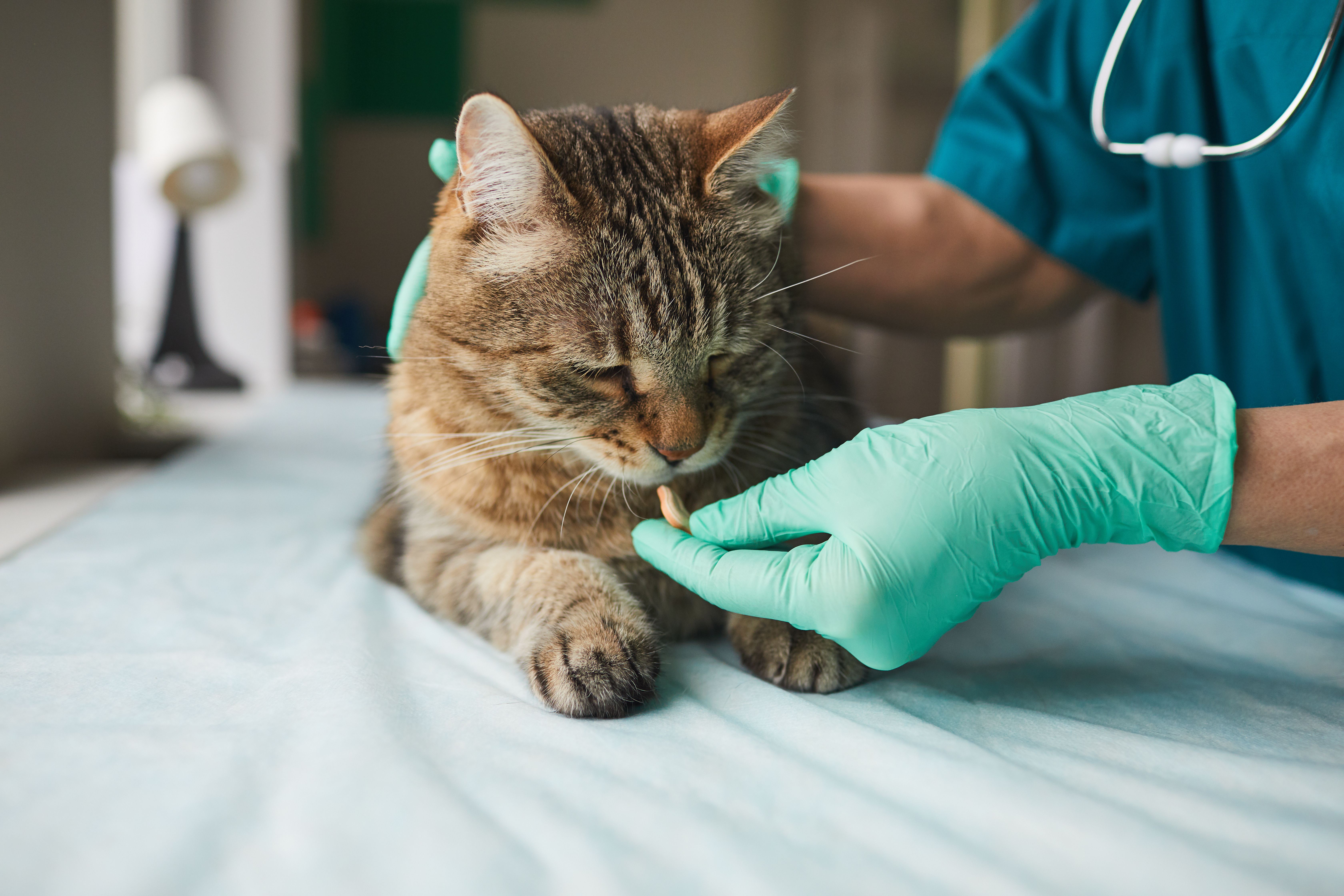Medicine to ease the feline mind
When environmental modification fails to mute stress-related responses, pharmaceuticals can provide much-needed relief
AnnaStills/stock.adobe.com

As more becomes known about the mind of cats, certain behavioral drugs are lending off-label succor to the feline psyche. These drugs are not FDA approved.
Meghan Herron, DVM, DACVB, senior director of behavioral medicine at Gigi’s Behavior Services in Winchester, Ohio, presented the various classes of pharmaceutical agents that work wonders to quell anxious cats. In “Integrated Care: Psychopharmacology, Nutrition, and Supplements,”1 a lecture Herron gave at the 2022 American Association of Feline Practitioners (AAFP) Annual Conference, she described 2 strata of psychotropic therapy: event drugs and daily, also known as standing, medications.
Daily medications, which take weeks to reach effect, are given continually and on schedule. “It doesn’t matter whether there’s a stressor or not,” Herron explained. “We still give them each day.”
Cats with a high baseline level of anxiety – which may present as inter-cat aggression, urine marking, separation anxiety, self-mutilation, or generalized fear – are candidates for standing psychotropics. Event drugs, on the other hand, have a quick onset and a predictable ebb. These drugs are used when terror looms. “We have a known stressful event, and we time their administration for one to two hours prior to that event,” she said.
Daily medication
Selective serotonin reuptake inhibitors
Selective serotonin reuptake inhibitors (SSRIs) work by blocking the reuptake of serotonin by the presynaptic neuron, thereby keeping the postsynaptic membrane flooded with this “well-being” chemical. The drugs mute anxious behaviors like urine marking, aggression, and self-mutilation.
Early side effects, including lethargy, decreased appetite and gastrointestinal (GI) distress, wane as the serotonin receptors down-regulate with time. Simultaneously, autoreceptors upregulate to jump-start serotonin synthesis and produce clinical improvement, but this can take 4-6 weeks.
The main SSRIs used in cats are fluoxetine (Prozac/Reconcile), paroxetine (Paxil), and sertraline (Zoloft). Out of these drugs, fluoxetine is the drug most used in cats.
Herron explained a study in cats that were urine marking and not responding to other remedies like litter box modification and environmental enrichment: The addition of fluoxetine lessened the behavior by 90% and pares down psychogenic alopecia. Though it modulates aggression, Herron, warned of rare instances in which the drug can raise it in already feisty cats.
Other fluoxetine side effects include lethargy and reduced grooming. Because it curbs appetite, fluoxetine may place finicky and obese cats at risk for hepatic lipidosis, and diabetic cats in danger of hypoglycemic episodes. Urine retention is a rare but possible adverse effect of fluoxetine.
Paroxetine and sertraline both have similar efficacy to fluoxetine; sertraline is appetite suppressing – though less so than fluoxetine, while paroxetine is appetite-stimulating. Other adverse events for paroxetine include lethargy, decreased grooming, and anticholinergic responses, such as constipation and dry eye. Due to its short half-life, paroxetine is not optimal for patients who might miss a dose.
Sertraline has a lower adverse event profile than fluoxetine, is metabolized by the liver, and is the safest daily medication for cats with kidney disease and epilepsy.
Tricyclic antidepressants
Tricyclic antidepressants (TCA) block reuptake of both serotonin and norepinephrine, thereby extending the availability of both. Their potency rests mostly in the work of serotonin, though norepinephrine also regulates anxiety. TCAs have anticholinergic action, which confers heftier side effects, but they also offer antihistamine properties, which bring calming vibes.
Though generally not the first choice for cats, Herron said, “TCAs can offer our bully cats that are constantly tormenting the other cats in the household that extra chillout factor.” This “chillout” sets in sooner for TCAs – about 4 weeks after the start of treatment – than for SSRIs.
The TCA clomipramine (Clomicalm), FDA-labeled for separation anxiety in dogs, is the most popular TCA in cats. Its antihistamine properties soothe, but its moderate anticholinergic action contraindicates it for cats with glaucoma, keratoconjunctivitis sicca (KCS) and chronic constipation. It should also be avoided in cats suffering seizures or cardiovascular disease. Rarely, urine retention can occur.
Amitriptyline (Elavil) is an acceptable third or fourth line of treatment for anxious cats. It has been shown to prevent flare-ups in cats with chronic interstitial cystitis but can cause significant sedation and severe anticholinergic effects.
Azapirones
These serotonin agonists mimic serotonin activity by binding to its receptors. Buspirone (Buspar) – the only azapirone commercially available in the U.S. – profoundly affects feline behavior and pulls scared cats out of their shells, earning the nickname the bravery drug by Herron.
Because buspirone brings out boldness, it is only suitable for NON-aggressive cats. It is also used to halt urine marking, buspirone ushers in clinical improvements 1-2 weeks after therapy is initiated. On the downside, buspirone is best given twice daily and can cause mild side effects, including increased friendliness, assertive social interactions, exacerbation of existing aggression, and rarely sedation or agitation.
Monoamine oxidase inhibitors
Monoamine oxidase inhibitors (MAOIs) downregulate monoamine oxidase B, sparing the key neurotransmitters norepinephrine, serotonin, and dopamine. By enhancing the latter, the MAOI Selegiline (Anipryl) slows the progress of cognitive dysfunction syndrome (CDS) in cats. Side effects, which are uncommon, consist of sedation, lowered appetite, GI upset, and irritability, along with several drug interactions.
All the standing anxiolytics can be given in overdoses that drown the synaptic cleft in serotonin. This can result in serotonin syndrome, a potentially deadly physiologic storm characterized by agitation, seizures, hyperthermia, and tachycardia. The antihistamine cyproheptadine is used to treat serotonin syndrome.
Whatever daily therapy is chosen, the mark of efficacy, Herron reminded, is a clinical improvement for a period of 90 days. Medicated cats should be monitored with exams and blood work annually (twice a year in cats over 10 years of age).
Event pills
Gabapentin
Traditionally used for chronic and neuropathic pain, gabapentin lessens stress in cats when given at a dose of 100 mg per cat (dose range is 50-200 mg/cat) 90 minutes prior to an anxiety-provoking event, such as placement into a carrier. Herron called gabapentin a “game-changer for handling compliance in cats.”
Trazodone
Trazodone has also been shown to boost feline handling compliance and reduce fearful postures. However, improvements can be variable and may take a few hours to achieve.
Clonidine
This alpha-2A adrenergic and imidazoline receptor agonist decreases angst and hyper-alertness by slowing norepinephrine release in the reticular activating system. Hypotension is a potential consequence of clonidine, and little data is available on its use in cats.
Benzodiazepines
These receptor agonists wear many hats including hypnotic sedatives, anxiolytics, muscle relaxants, anticonvulsants, and appetite stimulants. The optimal benzo choice for cats, said Herron, is lorazepam, which can be used daily for inter-cat aggression or on an as-needed basis for veterinary visits and/or car travel.
Acepromazine
A phenothiazine neuroleptic that functions as a tranquilizer rather than an anxiolytic, acepromazine can be piggybacked onto anxiolytics like gabapentin or lorazepam when greater sedation is needed.
Polytherapy
Herron explained that drug cocktails are used to fill gaps where a single agent is insufficient. For instance, when a daily anxiolytic-like an SSRI is the goal, event drugs can immediately cut noxious behaviors during the 4–6-week ramp-up period needed for the standing drug to start working: Start the event medication. Once the effective dosage is achieved, add the daily medication. As the benefits of the daily drug start to kick in, wean down the event drug.
Conversely, anticipated stress that might override the sanctuary bestowed by a standing drug can be faced off with an event drug on an as-needed basis. In cats for whom pain is a component of their behavioral issues, gabapentin can be used to augment daily therapy.
Soothing supplements and “comfort foods”
For stressed-out cats, relief doesn’t need to come in a pill. Vetoquinol’s Zylkene contains alpha-casozepine, which comes from cow’s milk, binds to GABA receptors, and delivers rapid anxiolysis without sedation. Purina Pro Plan Veterinary Supplements Calming Care contains probiotics that may help cats cope better; therapeutic progress may take about six weeks. Solliquin, by Nutramax, incorporates serotonin precursors and other compounds that relax cats quickly. Royal Canin Calm diets work in a similar fashion.
Sneaking it down the hatch
These barriers come in different forms, from gelatin capsules that mask medication taste, to enticing hides, like Pill Pockets, Easy Cheese, and butter. There is also liquid or treat compounding and, when all else fails, transdermal formulation.
Drugs do no good outside the body but most cats balk at the taste. “You need to put a barrier between the bitterness,” Herron advised. When it comes to administering psychotropics, building owner compliance builds compliant cats.
Reference
Herron, M. Integrated Care: Feline Psychopharmacology, Nutrition, & Supplements. Presented at: 2022 American Association of Feline Practitioners Conference, Pittsburgh, Pennsylvania. October 27-30, 2022

Inhaled albuterol offers more accessible treatment option for elevated potassium levels in cats
April 2nd 2025A recent study explored the effect of inhaled albuterol sulfate in reducing blood potassium levels in felines, which offers a potential treatment option for urinary obstruction-related hyperkalemia
Read More